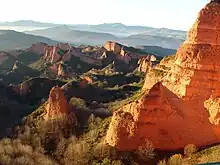Castile and Leon
autonomous community of Spain
Castile and León (Spanish: Castilla y León) is an autonomous region of Spain, taking its name from the many medieval castles that it is home to. Castile and León is the largest subnational political division in the European Union. It is formed by the union of two ancient kingdoms: Old Castile (Provinces of Ávila, Burgos, Segovia, Soria, Palencia and Valladolid) and the Kingdom of León (Provinces of León, Zamora and Salamanca), which were separated and reunited several times in the Middle Ages. Castile and León is actually larger than some European countries, such as Portugal, Belgium or the Netherlands.
There are eight World Heritage Sites in the region, which makes it the region with most in the world. Tourists are drawn to it by the historical and cultural value of its cities, as well as the natural and scenic attractiveness of its various mountain ranges.
The World Heritage cities: Ávila, Salamanca and Segovia; the cathedrals in León and Burgos and the Way of St. James, which passes through the provinces of Burgos, Palencia and León, are the mainstays of cultural tourism in Castile and León.
It is a very flat region in its centre, but very mountainous in its borders. It is totally surrounded by several ranges that separate it from the rest of Spain, being the most remarkable mountains the Picos de Europa in the provinces of León and Palencia, Gredos in Ávila and Guadarrama in Segovia. There are two national parks (Picos de Europa and Guadarrama) and seven natural parks, in the provinces of Burgos (2 parks), Palencia, Salamanca, Segovia, Soria and Zamora (2 parks). All of them plenty of hiking routes.
There are several ski resorts, such as La Covatilla in the province of Salamanca, San Isidro in León, and La Pinilla in Segovia.
Castile and León hosts Holy Week celebrations, considered to be of International Tourist Interest, being the most renowned in Zamora, León and Valladolid, holding elaborate processions accompanied by the music of brass bands.
